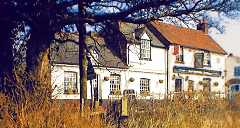|
A quiet village with several flint and red brick buildings, lying two miles east of Biggin Hill. The church of St Peter and
St Paul is of twelfth century origin, though much restored since. There is evidence that there has been a place of worship
on this site since 900BC and two yew trees in the churchyard may be seventeen centuries years old. Cudham’s landowners
have often been of noble birth but none have ever chosen to live here. In 1865 Richard Relph acquired the Blacksmith’s
Arms (see image below), a property that dates from 1628, when it was a real smithy. The landlord’s wife bore him fifteen
children, one of whom – born at the inn when Relph was at a remarkably advanced age – went on to become the celebrated
music hall star ‘Little Tich’. The houses and cottages of Cudham date mainly from the nineteenth century. Cudham
Hall served until recently as a trade union-run engineering college. The Angas Home has been a vicarage and a sailors’
convalescent home. The surrounding farms were once known for growing dyer’s weed (Reseda luteola), which produces
a yellow pigment. Its cultivation ceased when synthetic competitors rendered it uneconomic. Run by the Woodcraft Folk, Cudham
environmental activities centre is set within a three-acre woodland site on New Barn Lane. It has a residential field studies
unit, a camping area and a mini-farm.
 |

